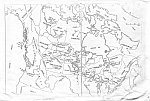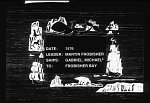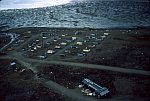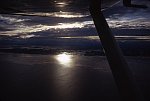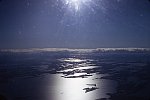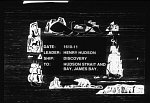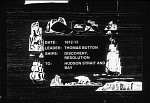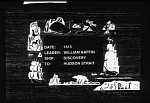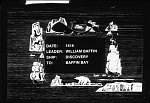Explorers and Northern Exploration
Author: Anne Mease Page 1 | Page 2 | Page 3
The exploration of Canada began with the Inuit approximately 80,000 - 12,000 years. Though credited as being the first explorers into Canada's Arctic they did not leave written documentation to show that the most northern territories had been discovered.
The rudimentary forms of exploration by Europeans into Canada began as early as 800 A.D. Apparently, the Norse (Vikings) from Norway colonized Iceland up to A.D. 874, then the Norse from Iceland under Erik the Red colonized Greenland in A.D. 986, and finally the Norse from Greenland repeatedly visited the Northeastern Coast of North America between about A.D. 1000 and 1350. [1] The Norse under the leadership of Leif Ericson, give the first glimpse of exploration into what would be Canada. An archeological dig in 1960 off the coast of N.F.L. (perhaps Vinyard) supports evidence of the Vikings having been to Canada long before other Europeans.
The Vikings reported meeting and confronting with the local inhabitants who they referred to as 'Skraelings.' The English translated 'Skraelings' to mean "wretches" or "savages." They were either Newfoundland Indians known as Beothuk or Dorset Inuit (Eskimo). Both of these Aboriginal groups are now extinct or absorbed into other Aboriginal groups.
The Dorset over time were absorbed or displaced by the Thule about A.D. 1000-1100. When Martin Frobisher visited the Arctic Coast in 1578 the Thule had already evolved into Inuit. Though not a proven theory but thought by many is that the Beothuk were exterminated by the French or bounty Indians (Mi'kmaq) in the 1700s. Others postulate that the Beothuk were decimated through disease or they still exist through exogamy or marrying into other bands.
In any instance, the Norse was not successful in their endeavor to colonize Canada as they were in colonizing Iceland and Greenland. This was due to the fact that the Vikings lacked the technology that the original inhabitants possessed such as bone, stone, and wooden tools and experience to survive the harsh environment. In addition, they could not support the population required to colonize another territory.
Inuit in the Canadian Arctic were still coming into contact with Europeans for the first time as late as 1918. Their period of contact lasted over nine hundred years. For other Aboriginal peoples in Canada, the duration of contact is about 400 years.
The Age of Discovery
Beginning in the early 1400s is the period known as the Age of Discovery. Marco Polo (1254-1324), an Italian explorer, had some two hundred years earlier told stories of a place called Cathay in the Orient. He apparently spent seventeen years with Kublai Khan who was the ruler of Mongol. In this place, luxurious spices were abundant but trade of these valuable spices to Europe only occurred by land through a "camel caravan route from the faroff 'Indie's.'" [2] Polo was scoffed at when he suggested that the Orient was "some twenty-five hundred nautical miles away...and...could be reached by ship."[3] This was unheard of because during the Elizabethan era it was believed the earth was flat and if you went too far, you would fall off.
Nonetheless, the words of Marco Polo would begin one of the greatest, longest and most tragic sequences of events as hundreds of experienced and un-experienced explorers and common folk would search for the Northwest Passage, a route that connects the Arctic archipelago of Canada to the Atlantic and Pacific Oceans. It is reported that well over seven hundred explorers and crewmen perished at sea or on land while in search of the Passage over hundreds of years.
John Cabot (1450?-1498)
Giovanni Caboto or John Cabot as we know him was born in Genoa, Italy in about 1450. Cabot, as with many other explorers during the age of geological discovery would be in search of the Northwest Passage that would lead to an easier and shorter route to the Orient.
His competition was none other than Christopher Columbus (1469-1524), also from Genoa. Both Columbus and Cabot were influenced by the accounts of Marco Polo and both were sure they would be the first to find the passage that would lead them to the Orient. Columbus headed south while Cabot headed north. Apparently, "Cabot reasoned that, since the world is round and distances decrease polewards, a northwest passage would ultimately prove to be the shortest route to take traders to the spiceries of northeast Asia." [4]
They separately approached England, Portugal and Spain to finance their expedition to find the Northwest Passage. Columbus was supported by Portugal while England, under King Henry VII agreed to finance Cabot. When Columbus victoriously claimed to have reached Cathay in 1492, "Cabot knew from his research that Cathay had not been reached, and he was determined to be the first man to do it." [5]
On May 20, 1497, Cabot, his three sons and ' eighteen' crew member's set sail on the Matthew in search of the Northwest Passage. Aside from his three sons, the crew consisted of convicts just released from jail. They were afraid of going because to "superstitious seamen, the most horrendous bogy was the prospect of tumbling off the edge of the world." Additionally, the only type of navigational tools they possessed was "a half-hour glass of trickling sand which told the time, a crude astroble which told the latitude of the North Star, a compass whose mariner's needle pointed to the magnetic north pole, and dreamlike maps whose blank spaces were filled in with pictures of ship-swallowing whirlpools and demigorgons." [6]
Thirty-five days later Cabot was one of the first Europeans to anchor ship on the Coast of Newfoundland or Cape Breton. The exact location is unknown but more recently it is thought to be "in the vicinity of the Strait of Belle Isle."[7] At " five o'clock in the morning of June 24, 1497" [8] he claimed the coastline of Newfoundland and Cape Breton for England by placing a crucifix, British flag, and "the emblematic lion of Venice"[9] on the land he had just 'discovered.'
Although Cabot himself did not leave written records of his voyage it is indicated "that the seawaters around Newfoundland were swarming with fish" and within "four or five years of his first voyage,"[10] fishermen from European countries were fishing commercially in Canadian waters. By 1578, those same waters were the livelihood for thousands of Europeans who came to fish there every year.
In any event, Cabot did not find the Northwest Passage but he did find another valuable European commodity, codfish. King Henry was so impressed with Cabot's discovery of the abundance of cod that he "was lionized as the Grand Admiral, a title that English folk deemed loftier than that of his rival Columbus, who was Admiral of the Ocean Sea."[11]
In May 1498 Cabot set out on his fateful second voyage with five ships and three hundred men in search of the Northwest Passage. It is not certain how or where Cabot and his crew perished but apparently his son Sebastian survived and assumed all the credit for his father's first and second exploration to Canada.
Cabot's final expedition only heightened the frenzy to find the Northwest Passage and many to follow him would change the course of history through rugged expeditions that would lead into Canada's Arctic archipelago.
Martin Frobisher (1539 - 1594)
Martin Frobisher, an expert sea navigator like other explorers of the day was in search of the Northwest Passage to the Orient. He claimed 'to make a sacrifice unto God of his life rather than return home without the discovery of Cathay.'[12] Frobisher and his crew made three separate expeditions into Canada's Arctic in 1576, 1577 and 1578.
On his first voyage to Canada in 1576 Frobisher was equipped with two privately funded ships named the Michael and the Gabriel. The Michael, was named for Michael Lok, who privately funded Cabot's expedition.
His first voyage took him through the southern tip of Greenland into what is now known as Frobisher Bay on Baffin Island. There he came into contact with Inuit traveling in kyaks and umiaks. During the process of trade a misunderstanding occurred, violence erupted, and five of his men were killed. Frobisher returned to England on 'August, 25' after realizing the danger of being outnumbered by the Inuit who were increasingly becoming angered by their presence. One Inuit was captured and returned to England but he did not survive long once in foreign lands. Frobisher also took with him samples of 'black gold' that later turned out to be 'pyrite.' Nonetheless, this discovery of 'gold' warranted a second voyage by Michael Lok and Queen Elizabeth I in 1577.
Equipped with three ships and 127 men, Frobisher set sail, "Meta Incognita-Goal Unknown"[13] from England for the second time in May 1577. They docked near present day Resolution Island that he named "Queen Elizabeth's Forelande"[14] Again Frobisher became embroiled in conflict with the local inhabitants and when violence ensued he was forced to flee but not before they found the precious metallurgy they were in search of. When he returned home on August 23 he took with him an Inuit man, woman and child and "two hundred tons of ore" that he presented to an elated Queen.[15]
By his third voyage in 1578 into Canadian waters, Frobisher was no longer in search of the Northwest Passage but rather for gold. He brought with him fifteen ships and one hundred men to set up the first colony and a mining operation to extract the gold. Many of the ships were destroyed or sunk by the large floes of ice that covered the ocean before they reached their destination and were forced to turn back. By this time, the authorities in England realized that the black gold was in fact pyrite. Upon his return home, Frobisher narrowly escaped jail for passing off 'fool's gold.'
Frobisher was not granted another expedition and he turned his efforts to pirating where he perished at sea while on a pirating expedition with Sir Francis Drake.
Hundreds of years after Frobisher's exploration, evidence of his presence is found in the frozen ground where he searched for the 'gold' that turns out to be "the world's richest mountain of highgrade iron ore."[16] While he did not find the Northwest Passage, it is noted "Frobisher's voyages contributed significantly to the science and technologies of cartography, promoting interest in the making and using of maps, charts, globes, and attendant literatures."[17]
Henry Hudson (1570-1611)
Henry Hudson was born in approximately 1570. He made four explorations into Canada and is known for discovering Hudson's Bay.
With financial backing from the Muscovy Company, Hudson set sail in 1607 on the Hopewell to find a quicker route through the Northwest Passage to the Orient. He took with him his twelve-year-old son Jack and eleven crewmembers. They traveled through the east coast of Greenland and along the east coast of Hudson Bay, hence the name.
Hudson came within 600 miles of the North Pole before turning back and is the first person to have a 'furthest North' record. On his return voyage home he 'discovered' a rich whaling and fishing area in the Svalbard Archipelego. Once he returned to England with this news they were no longer interested in funding another Artic exploration but rather to send ships to where the abundant supply of marine life was located.
The Dutch East India Company procured Henry Hudson in 1609 to resume his search to find a way through the Northwest Passage. Hudson and his crew set sail on the Half Moon on March 2, 1609. Hudson first came into contact with Aboriginal people he described as an Algonquin tribe who lived in log house structures along the Albany River. It is noted by Hudson's right hand man, Robert Juet, they killed several Indians who approached and pilfered their ship. Hudson returned home when he was threatened with mutiny by insubordinate crewmembers that were dissatisfied with the process of the voyage.
In 1610 a group of 'wealthy Londoners' commissioned Hudson to find a shorter route to the Orient. Hudson and a crew of sixteen to twenty-two men set sail on the ' Discovery.' This time, Hudson sailed along Iceland into Hudson Bay. They ended up somewhere near James Bay where they were forced to winter over when their ship became stuck in the ice.
The voyage on the 'Discovery' would prove to be Hudson's last voyage. Certain members, namely, Juet, of Hudson's crew mutinied against him, his son, and his loyal crew. Fifteen who were aboard the Discovery perished somewhere in the Hudson's Bay when they were sent adrift while the other eight returned to England without consequence for mutiny. ---About the North---
While Hudson did not find the Northwest Passage, he did find another valuable resource for England, the beaver. Hudson's disappearance initiated searches that would renew the endeavor to find the Northwest Passage.
Thomas Button (d. 1634)
Sir Thomas Button of Welsh descent "was selected in 1612 to command the expedition to find out what had become of Henry Hudson... and to complete "ye full and perfect discovery of the Northwest Passage." was also in search of an easier route to the Orient through the Northwest Passage. He set sail from England in May1612 on the Discovery and Resolution. Button's navigation route went through the Hudson strait, into the Hudson Bay and onto the Southampton Island.
Button set out again in 1615 and 1616 with William Baffin as the ship's pilot. Button thought that the entrance into Port Churchill was the passage to Cathay but instead he found a dead end he named 'Ne Ultra-Latin for 'Go No Farther.' After reaching latitude 62� he came to the conclusion that 'there is no passable nor hope of a passage to the north of Davis Strait, we have coasted all or near all the circumference thereof and find it to be no other than a great bay.'
While Henry Hudson is credited for 'discovering the southeast coast of Hudson Bay, Button "was the first to delineate the western shoreline of Hudson Bay."[18]
William Baffin (1584 - 1622)
Baffin was working as a Whaler for the Muscovy Company, in the Spitzbergen Archipelago, near Greenland in 1612 when a company called The Company of Merchants of London, Discoverers of the Northwest Passage approached him to lead an expedition to find the Northwest Passage.
On April 12, 1612 William Baffin, as pilot, and James Hall, set sail on the Patience in search of the Northwest Passage by way of Greenland. They reached latitude 67� N but were forced home by their Commander when Hall, was killed by Aboriginal people. It was not all a failure for Baffin because he "determined the longitude by observing the time of the moon's culmination."[19]
In 1615 Baffin piloted an expedition on the Discovery towards Cape Comfort and Southampton Island where they decided they could go no further. They returned home postulating that in order to go any further or to find the passage through one would need to go past Davis Strait. Baffin gained notoriety and thus, financial backing, for his ability to accurately locate the latitude by examining the flow of tides.
With Baffin as pilot and Robert Boyle as Commander, they set sail on the Discovery in 1616 to once again search for a way through the Northwest Passage. Boyle evidently was one of Henry Hudson's mutineer's. They headed past Davis Strait and 'discovered' Wolstenholme Sound and Smith's Sound. Baffin and his partner received the first ever 'farthest North' when they reached a latitude of '78 degrees' where they turned around after concluding that there was no passage not knowing they were the first to ever come closet to the Magnetic North Pole.[20] They felt they were heading in the wrong direction and turned South ward past Devon Islands where they 'discovered' Lancaster Sound.'
Baffin would hold the 'farthest North' record for almost two hundred years because it appeared that Baffin's expedition route held little importance to anyone thus no one followed the route he mapped.
Endnotes
[1] Jared Diamond. Guns, Germs and Steel: The Fate of Human Societies. W.W. Norton and Company: New York, 2000:371
[2] Frank Rasky. Explorers of the North: The Polar Voyagers. McGraw-Hill Ryerson Limited, Toronto. 1976:68.
[3] Ibid: 68
[4] Ibid: 68
[5] Ibid: 69
[6] Ibid: 74
[7] Ibid: 76
[8] Ibid: 66
[9] Ibid: 76
[10] Harris, R. Cole, and Warkentin, John. Canada Before Confederation: A Study in the History of Geography. Carleton Univ Pr, Ottawa, 1991:9.
[11] Frank Rasky. Explorers of the North: The Polar Voyagers. McGraw-Hill Ryerson Limited, Toronto.
[12] Ibid: 103
[13] Ibid: 111
[14] Thomas H.B. Symons. Meta Incognita: A Discourse of Discovery. The Canadian Museum of Civilization. Hull Quebec, 1999: ix.
[15] Frank Rasky. Explorers of the North: The Polar Voyagers. McGraw-Hill Ryerson Limited, Toronto. 1976: 115
[16] Ibid: 120
[17] Thomas H.B. Symons. Meta Incognita: A Discourse of Discovery. The Canadian Museum of Civilization. Hull Quebec, 1999: xxxi.
[18] Ibid: 239
[19] William Baffin: English Navigator & Explorer. <http://www.geocities.com/Athens/7012/bios/explorers/baffin.htm>
[20] Lawrence F. Jones and George Loon. Pathfinders of the North. Pitt Publishing Company,Toronto, 1969:25
